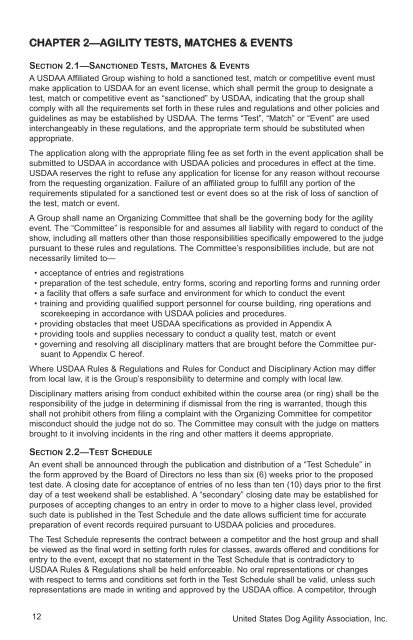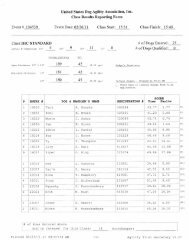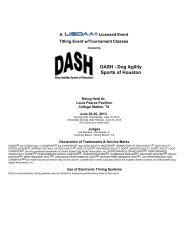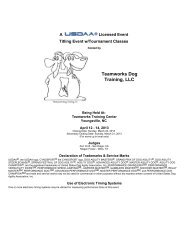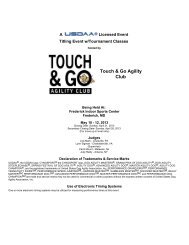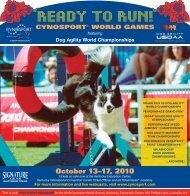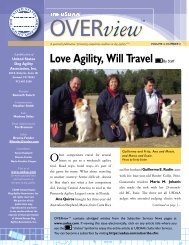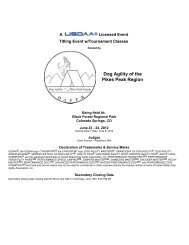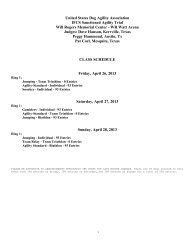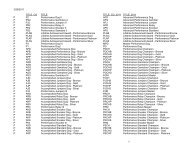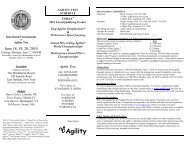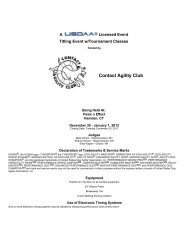Sanctioned Agility Tests, Matches & Events (updated 5/25 ... - USDAA
Sanctioned Agility Tests, Matches & Events (updated 5/25 ... - USDAA
Sanctioned Agility Tests, Matches & Events (updated 5/25 ... - USDAA
You also want an ePaper? Increase the reach of your titles
YUMPU automatically turns print PDFs into web optimized ePapers that Google loves.
CHAPTER 2—AGILITY TESTS, MATCHES & EVENTSSECTION 2.1—SANCTIONED TESTS, MATCHES & EVENTSA <strong>USDAA</strong> Affiliated Group wishing to hold a sanctioned test, match or competitive event mustmake application to <strong>USDAA</strong> for an event license, which shall permit the group to designate atest, match or competitive event as “sanctioned” by <strong>USDAA</strong>, indicating that the group shallcomply with all the requirements set forth in these rules and regulations and other policies andguidelines as may be established by <strong>USDAA</strong>. The terms “Test”, “Match” or “Event” are usedinterchangeably in these regulations, and the appropriate term should be substituted whenappropriate.The application along with the appropriate filing fee as set forth in the event application shall besubmitted to <strong>USDAA</strong> in accordance with <strong>USDAA</strong> policies and procedures in effect at the time.<strong>USDAA</strong> reserves the right to refuse any application for license for any reason without recoursefrom the requesting organization. Failure of an affiliated group to fulfill any portion of therequirements stipulated for a sanctioned test or event does so at the risk of loss of sanction ofthe test, match or event.A Group shall name an Organizing Committee that shall be the governing body for the agilityevent. The “Committee” is responsible for and assumes all liability with regard to conduct of theshow, including all matters other than those responsibilities specifically empowered to the judgepursuant to these rules and regulations. The Committee’s responsibilities include, but are notnecessarily limited to—• acceptance of entries and registrations• preparation of the test schedule, entry forms, scoring and reporting forms and running order• a facility that offers a safe surface and environment for which to conduct the event• training and providing qualified support personnel for course building, ring operations andscorekeeping in accordance with <strong>USDAA</strong> policies and procedures.• providing obstacles that meet <strong>USDAA</strong> specifications as provided in Appendix A• providing tools and supplies necessary to conduct a quality test, match or event• governing and resolving all disciplinary matters that are brought before the Committee pursuantto Appendix C hereof.Where <strong>USDAA</strong> Rules & Regulations and Rules for Conduct and Disciplinary Action may differfrom local law, it is the Group’s responsibility to determine and comply with local law.Disciplinary matters arising from conduct exhibited within the course area (or ring) shall be theresponsibility of the judge in determining if dismissal from the ring is warranted, though thisshall not prohibit others from filing a complaint with the Organizing Committee for competitormisconduct should the judge not do so. The Committee may consult with the judge on mattersbrought to it involving incidents in the ring and other matters it deems appropriate.SECTION 2.2—TEST SCHEDULEAn event shall be announced through the publication and distribution of a “Test Schedule” inthe form approved by the Board of Directors no less than six (6) weeks prior to the proposedtest date. A closing date for acceptance of entries of no less than ten (10) days prior to the firstday of a test weekend shall be established. A “secondary” closing date may be established forpurposes of accepting changes to an entry in order to move to a higher class level, providedsuch date is published in the Test Schedule and the date allows sufficient time for accuratepreparation of event records required pursuant to <strong>USDAA</strong> policies and procedures.The Test Schedule represents the contract between a competitor and the host group and shallbe viewed as the final word in setting forth rules for classes, awards offered and conditions forentry to the event, except that no statement in the Test Schedule that is contradictory to<strong>USDAA</strong> Rules & Regulations shall be held enforceable. No oral representations or changeswith respect to terms and conditions set forth in the Test Schedule shall be valid, unless suchrepresentations are made in writing and approved by the <strong>USDAA</strong> office. A competitor, through12United States Dog <strong>Agility</strong> Association, Inc.
No dog shall be permitted to compete at an event whose owner or handler has not—• presented a permanent registration card, (or official letter of certification that permanentcard is approved or pending by the <strong>USDAA</strong> office)• presented a “certified” temporary registration card (i.e., one that has been properly completedby three or more judges),• had the dog measured by a judge of record for the event, or• otherwise had this dog pre-qualified for entry in a height class at a tournament event.The measuring judge other than a Certified Measuring Judge (CMJ) must be a judge of recordfor the event, including a supervising judge of record or a judge engaged solely for that purpose.The measuring judge’s determination shall be final for the event, including any contiguousdays conducted by another <strong>USDAA</strong> group. All judges performing an official function mustfile a Judges Report following the event, even if engaged solely for measuring.SECTION 2.4—OBSTACLESOnly the obstacles listed below and meeting the specifications provided in Appendix A to theseregulations may be used at <strong>USDAA</strong> sanctioned tests or events.Contact ObstaclesJumps and HurdlesDog WalkTire JumpSee-SawViaductA-FrameLong JumpWeave PolesBrush JumpCollapsed TunnelWinged HurdlesPipe TunnelNon-winged HurdlesTableSpread HurdlesVarious additional hurdles or specialty obstacles may be offered at an event provided theymeet the parameters of other obstacles as set forth in Appendix A or they are approved inadvance in writing by the <strong>USDAA</strong> office. Safety must always be of foremost concern whendesigning and constructing obstacles. Obstacles not contemplated by these regulations maynot be utilized in tournament or title certification classes.A majority of the jumps and hurdles (including spread hurdles) utilized shall be of the “winged”type, with wings measuring no less than 16”(40cm) in width. Poles or rails on a majority of hurdlesand jumps shall be no less than 54” (137cm) and on spread hurdles at 60” (152cm).Obstacles should be spaced on average 15’ to 22’ (4.5m to 6.5m) distance along the dog’s naturalpath between obstacles. Successive obstacles shall not be spaced closer than 12’ (3.7m).In events where dogs of all jump height classes are competing against each other in an openclass, obstacle spacing should be balanced with all other competitive elements of the course todistribute competitive challenge among all sizes of dogs.SECTION 2.5—COURSE LAYOUTA performance ring should meet the following size requirements:PROGRAMChampionship/Performance(Masters & Tournament Classes)Championship/Performance(Advanced Classes)Championship/Performance(Starters Only Classes)Intro & Junior Handler OnlyMINIMUM AREA*Square FeetSquare Meters Dimension8,0008007,0007006,0006003,20032080’24m60’18m60’18m40’12mRECOMMENDED AREASquare FeetSquare Meters Dimension10-12,0001,000–1,2008,0008008,0008004,800480100’30m80’24m80’24m60’18m*A variance of 10% is permitted on these measurements. Should a facility not allow for these dimensionsafter allowance for the variance, a group may request a waiver from the <strong>USDAA</strong> office.United States Dog <strong>Agility</strong> Association, Inc.15
It is the sole responsibility of the host group to establish whether a facility meets these requirementsthrough gathering of sufficient information and conduct of tests of the material or surfaceto determine that such facility is suitable pursuant to these regulations. The performance ringsurface must permit leveling of the obstacles and provide safe footing for handlers and dogs.Sod and packed dirt as used for equestrian events have been tried and proven throughout thesport’s history as the most suitable surfaces that are safe for the sport of dog agility. Hard surfacessuch as cement or asphalt shall not be used unless these surfaces are adequately coveredwith suitable surface material that has been evaluated and tested for impact, sure footingand general safety. Other surfaces may also be considered to be safe, but they must beapproached with caution. Should weather deteriorate a surface to the point that the judgeand/or Organizing Committee deem that it is no longer safe for competitors and/or their dogs,the event shall be relocated, postponed or cancelled as appropriate for the circumstances.Safety for handler and dog shall be paramount in selecting an event site.The course layout shall be designed by the judge and reviewed by an independent coursereviewer pursuant to guidelines established by the <strong>USDAA</strong> Board of Directors. The course shallbe constructed under the judge’s direction utilizing at least the minimum obstacle requirementsfor a specific class as stated in these rules and regulations. The judge shall post the coursedesign for competitor inspection a reasonable time prior to the start of the class. Competitorsshall not under any circumstances be allowed to take their dogs onto the test course prior tocompeting, except in the Junior handler Program as set forth in Chapter 8 ; however, competitorsshall be allowed in the test area without their dogs to “walk the course” under directives bythe judge , thereby permitting inspection of the obstacles, course layout and terrain in contemplatingtheir handling strategy.The course area should be partitioned by rope or fencing to prevent spectators from interferingwith the course before, during or following the test. However, it must at all times be rememberedthat agility is a spectator sport, and accommodations should be made for spectators aswith any other public sporting event.A separate “warm-up” area may be provided near each ring at a show site to allow handlers anopportunity to heel and jump their dogs. Only a single jump of judge’s discretion shall be permittedin the “warm-up” area, which shall be under ring personnel supervision. No obstacles orjumps shall be permitted elsewhere at the test site for training, warm-up or other preparatorypurposes.Courses shall have a defined start line and finish line. The start and finish line shall be generallybe set within ten feet in front of the first obstacle and beyond the last obstacle and shall notbe set in a manner that may make the line an “obstacle” to be performed or a course hazard. Acourse shall require no more than 20 obstacles be performed by a single dog, including anyobstacles to be taken more than once. The start and finish line are intended solely as a meansof measuring time on the course. The clock shall start when the dog crosses the start line andstopped when the dog crosses the finish line after performance of the final obstacle on course.Special guidelines are set forth in Appendix G to these regulations for use of electronic timingequipment.If the judge encounters a specific obstacle that meets obstacle specifications but may vary inappearance or operation such that the judge views a lack of familiarization may create a significantperformance or safety problem for dogs, the judge may set the obstacle in the warm-uparea for a period of time prior to the class in which it is to be used so that competitors mayfamiliarize themselves with it (e.g., uniquely styled jump, such as a wishing well, see-saw witha different tilting mechanism, etc.) A judge in such circumstances must give careful considerationas to the obstacle’s operational safety before permitting it to be used in the test.Training collars, such as choke chain, pinch or similar collars commonly used in training shallnot be permitted in or near the ring or warm-up area (or other spectator areas). “Similar collars”as used above shall be evaluated based upon their intended function and appearance. Shockcollars or similar devices not deemed to be in the best interest of the sport shall not be worn orbe used on the show grounds.16United States Dog <strong>Agility</strong> Association, Inc.
No training seminars or practice sessions, other than regularly scheduled classes at the facility,shall be held at the event site one day prior to or during the event without written <strong>USDAA</strong>approval. <strong>Sanctioned</strong> matches, Junior Handler and Intro Program classes are exempt from thislimitation.SECTION 2.6—JUDGES & STEWARDSA class shall be conducted by one judge and several stewards under the judge’s direction. At aminimum each ring of operation should have a timer, scribe, gate steward, scorekeeper, andtwo to four ring stewards; course builders can generally service more than one ring at anevent.A judge shall not be allowed to compete in the event on a day that they are scheduled to judgewithout <strong>USDAA</strong> approval. Primary stewards (i.e., scribe, timekeeper and scorekeeper) shall notbe permitted to compete in a class for which they serve as stewards. For this purpose, a classis defined as a competition for which awards are being offered. (For example, a class would bea jump height grouping in a class if placements are made only by jump height; in Snooker, iftwo height classes are combined pursuant to rules set forth in Chapter 6, the combined class isconsidered a single class for this purpose). Only individuals who are listed on the “ApprovedJudges List” evidencing that they have fulfilled the <strong>USDAA</strong> requirements for judges (seeAppendix B) shall be permitted to judge at a sanctioned test or event pursuant to guidelinesestablished by the <strong>USDAA</strong> Rules & Regulations Board, except as provided in the JuniorHandler or Intro Programs (see Chapters 8 & 10), or otherwise with <strong>USDAA</strong> written approval.The judge shall be solely responsible for designing the course, measuring the course distance,establishing the standard course time, measuring dogs and scoring the performance. Thejudge shall consult with the Event Secretary in determining whether fault limits are to be utilized.When the secretary shall indicate that fault limits have been considered in establishingthe class schedule, the judge shall utilize fault limits no less stringent as those assumed in settingthe class schedule. Where the secretary indicates that fault limits were not anticipated, thejudge may apply (at their discretion) reasonable fault limits in exercising their duties pursuant toSections 3.3 and 3.4 of these regulations. While the test secretary or Organizing Committeeare responsible for scheduling the classes and number of rounds per day, the judge is responsiblefor maintaining the schedule and maintaining general efficiency of ring operations.The judge shall be responsible for building of the course to assure that the course is presentedas designed and as approved by the course reviewer. In the event of unexpected circumstancesat an event, such that approval of a needed change cannot be reviewed and approvedby a reviewer (e.g., different ring dimensions or unanticipated obstructions or other hazardswithin the ring area), the judge is empowered to modify the course to the extent necessary toconduct the class in a safe manner, while retaining the principal elements of the originaldesign. Should an obstacle fail and cannot be repaired promptly, or weather should make anobstacle unsafe or fail, the judge is empowered to substitute an obstacle of similar characteristicsif possible to preserve the integrity of the course. The judge must submit a revised coursediagram with an explanation for the change with their Event Judge’s Report, if any changes aremade to the course as previously approved.The judge shall designate stewards to serve as timekeeper and scribe for a class, but thejudge alone shall observe and signal course faults. The judge’s decision on scoring shall befinal. Use of video or other means of instant replay shall not be utilized for the determination ofcourse faults, except as may be provided in an official <strong>USDAA</strong> written policy statement.However, should time be lost on a round due to timekeeper error or clock failure, the judgeshall first determine if any objective measure of the actual performance time can be determinedthrough video. Absent such objective determination, the judge may call for a re-run of the roundfor time only. Any course faults incurred on the first run of the course (or partial run, if a run ishalted before it is finished) shall be remain as part of the competitor’s score, and the competitorshall seek to run the course in a similar style, with the judge adjusting the time for any differencesin the performance as deemed necessary to approximate time.The judge shall hold a competitor’s briefing prior to the commencement of each class, unlessdetailed briefing notes have been set forth in writing and posted along with a copy of theUnited States Dog <strong>Agility</strong> Association, Inc.17
course plan. When given, the briefing may include as applicable, a review of special scoringand performance requirements for the class to the extent appropriate for each class or classlevel, announcement of the standard course time and fault limit (if one is to be used), and areview of ring procedure (e.g., entering and exiting the ring, approaching the start line, etc.).The judge shall not advise competitors on handling position or strategy but may at his or herdiscretion respond to questions on what may be permissible or not within these rules and regulations.The judge shall provide a written briefing on all special scoring and performance rules forGamblers and Snooker classes (or other classes that may require special rules), which shall beposted along with the course design.The judge shall seek to maintain the running order established by the Event Secretary in orderthat the event may run efficiently. Should the judge determine that adjustment of the runningorder may be needed, the judge shall consult with the Event Secretary, Gate Steward andother key event personnel and judges to assess whether the change is conducive to efficientshow operations and whether such change may impact the competitive strategies of competitorsin a particular class.The class scorekeeper shall be positioned ring-side at the exit gate where they shall receivethe scribe sheet, tally and post scores immediately following each round pursuant to <strong>USDAA</strong>policies and procedures. This practice enables competitors the opportunity to promptly reviewtheir scores and make timely inquiry should a discrepancy be noted, as well as to provide thejudge with instant access to the scorekeeper to respond to queries and to facilitate ring operations.SECTION 2.7—PRIZES & AWARDSA host organization shall recognize each qualifying score in a certification class through theaward of a maroon qualifying ribbon or rosette. Placements shall be named and listed in theofficial event results to the extent of awards to be recognized for the class, including Top Tenawards. Ribbons, rosettes and other prizes may be awarded to a reasonable number of placementsat a club’s discretion (generally 10–15% of entry), unless otherwise set forth in <strong>USDAA</strong>tournament rules or official policy statements. Placement ribbons or rosettes shall follow thecolor chart provided below.Each ribbon or rosette should have prominently imprinted the <strong>USDAA</strong> logo, name of the hostorganization, and the words “<strong>Sanctioned</strong> Test” or “<strong>Sanctioned</strong> Event” and for a qualifying ribbon,the words “Qualifying Round” in lieu of the designated placement.The following primary colors shall be used for placement ribbons and rosettes:1st Place Blue 5th Place Pink 8th Place Brown2nd Place Red 6th Place Green 9th Place Gray3rd Place Yellow 7th Place Purple 10th Place Lt. Blue4th Place WhiteAdditional placements shall be light blue in color.Trophies may also be awarded for prizes provided they are adequately described andannounced in the Test Schedule. Cash awards and prizes must be approved by the <strong>USDAA</strong>office in advance if in more than nominal amounts as may be set through <strong>USDAA</strong> policy statements.Prizes and ribbons for tournament classes and others that are held before public audiencesshould be awarded immediately following each class so as to provide instant recognition ofwinners and association of the winner with the designated award.CHAPTER 2 FOOTNOTES2.01 Under no circumstances should a temporary card be signed for dogs under 18 months of age. Dogsunder 18 months are only eligible for entry to Intro Program classes, and measurements are for event only.2.02 This provision is effective for events after June 1, 2011, and must comply with published policy statements.18United States Dog <strong>Agility</strong> Association, Inc.


